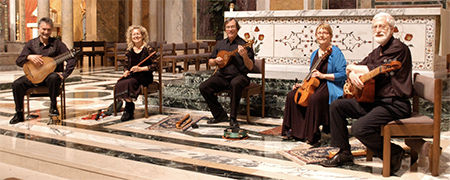by Nicholas Stevens

On Sunday afternoon, October 28, soprano Danielle Svonavec joined the five instrumentalists of the Consort for a program organized into interconnected clusters of pieces. Tunes flowed into one another via improvised transitions, and in a program of music written centuries before the norms of the 19th-century symphony concert took hold, no one ever wondered when to applaud.
Mark Cudek’s cittern, a strummed Renaissance instrument, easily mistaken for the bouzouki of modern Irish folk music, generated a danceable rhythm in, and an ambient glow around, Svonavec’s melodies in John Forbes’s The Gowans are Gay. This led directly into Adew Dundee, an instrumental dance full of breezy runs of notes for Ronn McFarlane’s lute.
The set “Mirror of the Renaissance World” took listeners on a journey from the simple, mournful strains of the song Remember Me, My Deir, in which Svonavec literally paced with worry, to diverse instrumental dances. The two Canaries, named for their origins in the Canary Islands, bounced along with a winning lilt, and provided a welcome reminder that the period we call the Renaissance involved unprecedented colonialism. A ground-bass dance gave the players a chance to show off their knack for gradual builds in texture and activity, and a pair of Branles d’escosse gave Larry Lipkis and Mindy Rosenfeld an opportunity to handle crumhorns with all the rhythmic fluidity of jazz players.
Svonavec’s restrained manner and ornamentations allowed the poetry of Alexander Montgomery’s What Mightie Motion to shine. Crossing to Ireland, a Cape Breton folk tune, exemplified the group’s vivacious approach, with Lipkis making authoritative strokes on the bass viol. The performance of Gypsen Davey, shot through with archaic references to its title character’s ethnicity, landed uncomfortably between humor and earnestness, but the following selection from a collection titled Pills to Purge Melancholy cleared the air with sunny grooves.
Viols da gamba led off a lovely setting of the Lord’s Prayer with somber introductory bars, and Svonavec’s great moment in the light arrived with her unaccompanied rendition of the tune One Yeir Begins. With a melodic range of over two octaves, the song could easily sound like a technical exercise, but here it seemed to offer no particular challenge. Instead, it stood as a concert highlight. Many small songs and dances appeared on the second half, but the group’s approach to O Lustie May summarized their appeal in tidy fashion. Defiant of the fog outside, Svonavec sang of springtime as the instrumentalists ran victory laps around her every word, here flutter-tonguing in imitation of birdsong, there plucking viols to achieve the bounce and verve for which the group remains well known.
Published on ClevelandClassical.com November 1, 2018.
Click here for a printable copy of this article



